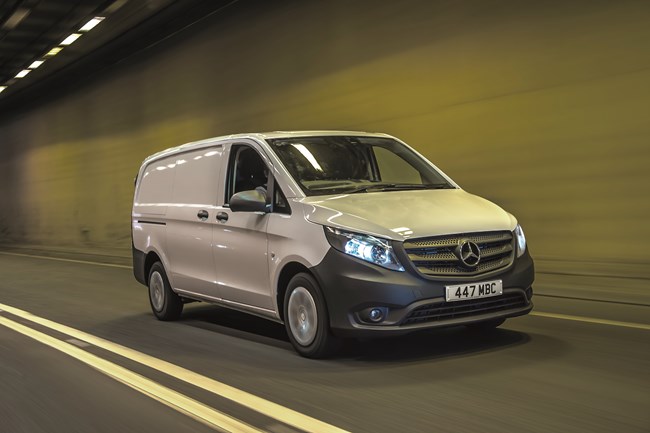- Tyres: The path of least resistance
- ETRUX receives Ford Pro Convertor status
- The Logistics Organisation adds to van fleet with Vanaways
- Northgate launches micromobility service
- Progress being made on shared EV charging, AFP reports
- Medisort electrifying van fleet with Bedeo
- ADVERTISEMENT FEATURE: Taking a shortcut to reduce commercial vehicle emissions
- The What Van? Road Test: Ford Ranger Raptor
- Speakers announced for Commercial Vehicle Show
- Check new vehicle registration details are correct, AFP tells fleets
Buying a used... Mercedes-Benz Vito (2014)
Date: Wednesday, February 2, 2022 | Author: Ian Shaw
The Mercedes-Benz Vito is not the cheapest of options, but you get what you pay for.

After a lack-lustre introduction, the Vito name was given more of a presence in 2014 with the renewed incarnation. It has undergone constant development since, mainly focussing on its dynamics.
The Vito comes in L1, L2, and L3 guises with overall lengths of 4.9, 5.1 and 5.4m respectively, with a width and height externally of 1.9m and 2.2m across the door mirrors. The load bay is 1.7m wide and 1.4m high internally with the three length options giving 2.4 2.7 and 2.9m of load capacity equating to load volumes of 5.5, 6.0 and 6.6m3.
Payloads range from 645 to 818kg as standard, which isn’t massive for the Gross Vehicle Weight of 2.8t. Mercedes did offer increased GVWs of up to 3.2t as extra cost options. Power for the Vito comes from a choice of four turbocharged diesel engines, or the plug-in all-electric version, the eVito. The diesels were badged 110CDI, 114CDI, 116CDI and 119CDI. They are offered with Progressive and Premium trims, and an additional Sport level for the Crew Van.
Progressive trim was the only one offered with a manual transmission, and these versions are front-wheel drive with the 110CDI or 114CDI-badged 1.7l diesel, only in L1 and L2 body lengths. Other versions of the Vito featured the larger 2.0l diesel and are rear-wheel drive allied to the 9G-Tronic automatic gearbox. Although a 114CDI manual had the 1.7l engine and front wheel drive, the 114CDI automatic has the 2.0l engine but with the same 134bhp output, driving the rear wheels.
This is the choice for higher payload and towing applications. It will handle a trailer of up to 250kgs. On fuel consumption the most efficient model is the rear-drive 2.0l diesel 114 CDI Premium in the L1 body style fitted with the 9G-Tronic auto, which has a quoted combined figure of 39.8mpg. This is mainly thanks to the nine gears offering a cog for every speed, incline and eventuality. By contrast the least efficient model is the 1.7l 110 CDI Progressive L3 front-wheel drive manual, at 36.7mpg, a sign that at this size and weight the smallest engine is being worked the hardest.
The driving position is as you would expect from a manufacturer of Mercedes-Benz’ standing. It is simply first rate. It might not be the cheapest option in the class but the Vito has excellent seats, great visibility, large mirrors and offers somewhat of a master-class in ergonomics.
With the Vito, it really is a case of you get what you pay for. The infotainment system trails some rivals, and cab storage space for oddments is also average rather than class leading, but for a long day at the wheel, it takes some beating.
Reliability is not all you would expect of Mercedes-Benz, with issues on the emergency call system, airbag warning indicators illuminating, power steering and immobiliser faults pointing to electrical glitches. However, the engines and drivetrains seem expectedly and Teutonically strong.
Five best options
1) 2.0l engine
2) Automatic transmission
3) L2 length
4) Premium trim
5) Sport trim Crew Van
Five best avoided
1) Lowest power 1.7l engine
2) Front wheel drive
3) Manual gearbox
4) L1
5) Earliest versions (pre-2014)
Second-hand buys
|
Version |
Plate |
Year |
Mileage |
Price ex.VAT |
|
110 CDI L1Progressive |
17 |
2017 |
67,000 |
£13,995 |
|
114 CDI L2 Progressive |
68 |
2018 |
74,850 |
£13,750 |
|
114 CDI L2 Progressive |
19 |
2019 |
31,900 |
£17,995 |
|
116 CDI L2 Progressive |
70 |
2020 |
28,500 |
£19,950 |
|
119 CDI L2 Premium |
21 |
2021 |
6,500 |
£32,999 |
View The WhatVan Digital Edition


